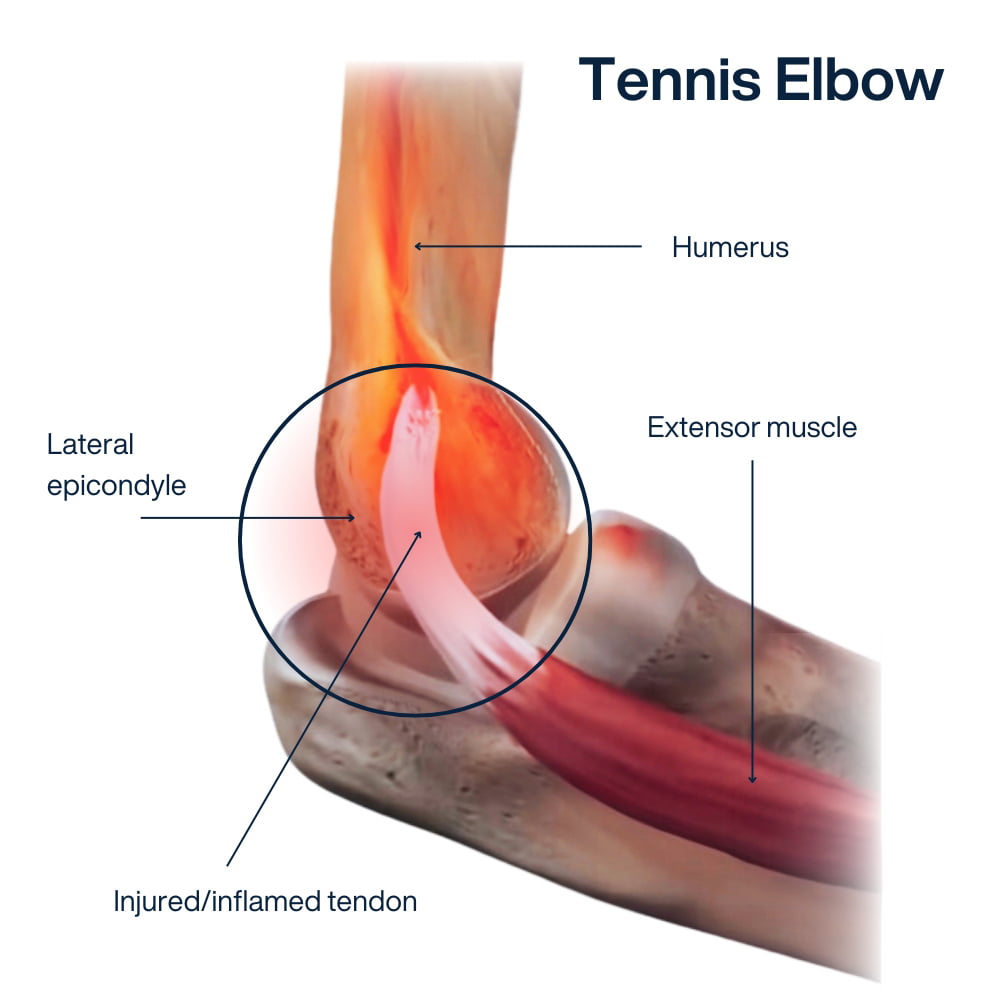Pain in your elbow when you straighten your arm can make it difficult to perform routine activities like reaching over your head, carrying grocery bags, or even putting on clothes. Elbow pain not only restricts your arm activity but your quality of life as well. At Pain Management NYC, Dr. Leon Reyfman works with you to determine the causes behind your joint pain and comes up with a treatment plan that helps manage your pain and regain your arm function successfully. He has extensive experience in a range of advanced treatments and procedures for the elbow and arm and ensures you are back to your routine activities as soon as possible.
The elbow is a small but one of the most complicated joints in the body. It connects the bones of the forearm to the upper arm bone through a network of ligaments and muscles and helps you with many different movements in your arm and hand, including rotation, extension, and flexing, often combining these motions at one time.
As it is a highly exercised and stressed joint, it is also vulnerable to injuries and conditions that can cause significant pain. It can sometimes be hard to find out what type of elbow movement leads to pain and when this pain is a sign of a serious injury that needs a trip to the pain doctor.
Possible Causes of Pain in the Elbow When You Straighten Your Arm
There are several reasons why you may have pain when straightening and bending your arm. Identifying the reasons behind your discomfort can help you seek effective treatment for your symptoms and prevent the risk of re-injury.
Tennis Elbow
 It refers to the inflammation of the tendon that attaches your elbow bone to the muscles that control your wrist and fingers. Also known as lateral epicondylitis, tennis elbow is a painful condition that usually occurs due to overuse or overexertion of the elbow during physical activities, such as swinging a tennis racket and repetitive movements at work. A burning sensation and sensitivity are usually felt on the outside of the elbow when you try to bend or straighten the joint.
It refers to the inflammation of the tendon that attaches your elbow bone to the muscles that control your wrist and fingers. Also known as lateral epicondylitis, tennis elbow is a painful condition that usually occurs due to overuse or overexertion of the elbow during physical activities, such as swinging a tennis racket and repetitive movements at work. A burning sensation and sensitivity are usually felt on the outside of the elbow when you try to bend or straighten the joint.It usually affects middle-aged people of any activity level, including baseball and softball players, fencers, gardeners, painters, and other professionals whose jobs involve repeated movements that can lead to overuse injury. The impact from repeated motions of the wrist and arm can place a lot of stress on the elbow, which irritates the tendon and causes it to become inflamed.
Golfer’s Elbow
It is a condition of the tendon or inner part of the elbow that causes pain where the tendons of your forearm muscles attach to the bony bump on the inside of your elbow. Also known as medial epicondylitis, it occurs when the muscles and tendons that control your wrist and fingers are damaged and inflamed. This damage is related to excess or repeated stress, particularly forceful wrist and finger motion.
Improper lifting, throwing, or hitting, work tasks that require you to grip tools tightly as well as too little warmup or poor conditioning, also can contribute to a golfer’s elbow. The pain is felt on the inside of the elbow when you straighten your arm. It can extend down the forearm and wrist as well. You may also experience numbness, tingling, or stiffness in one or more fingers.
Bursitis
It is the inflammation of the bursae, tiny sacs of fluid in the elbow, that prevent the tendons from rubbing against the bones and muscles. An accident, infection, or repeating the same motion over and over can cause the bursae to become inflamed and lead to bursitis.
Sometimes bursa fills with fluid. Your elbow may feel stiff or achy, look swollen and red, and hurt more when you move it or press on it. The swelling, pain, and tenderness can limit your elbow’s ability to bend or straighten.
Ulnar Nerve Entrapment
The ulnar nerve runs through the elbow joint, but there is little soft tissue to protect this nerve. As a result, even something as simple as leaning on your elbow too much can put pressure on the ulnar nerve in your elbow or wrist, trigger this issue, and cause pain on the inside part of the elbow. Also referred to as cubital tunnel syndrome, it can occur from overuse injuries, cysts, and other problems that can stretch or put pressure on the ulnar nerve.
You may experience hand and finger weakness, numbness, pain, or tingling as the ulnar nerve becomes constricted or irritated. Nerve entrapment is a type of nerve compression syndrome.
Biceps Tendinitis
It is the inflammation of the bicep tendon, which connects your bicep muscles to the inside of the elbow joint. Normal activities and everyday wear and tear can slowly weaken the tendons. This degeneration can be worsened by overuse and repetitive motions. It can cause pain and tenderness in the front of the shoulder or pain that moves down the upper arm bone as you move the elbow.
In case of severe damage, this tendon may rupture completely, which may cause intense pain.
Elbow Osteoarthritis
Osteoarthritis causes the cartilage in your joints to become thinner, and the surfaces of the joint to become rougher, as new layers of bone begin to grow. As the cartilage wears off, the bones rub against each other causing inflammation. The affected joint can feel stiff, swollen, and painful.
You will find it difficult to bend or stretch your arm and feel pain when you move your shoulder. Even simple activities like shaving or brushing can become a challenge. Although it is typically caused by age and genetics, prior injuries can increase the risk of elbow osteoarthritis.
Dislocation
When one of the bones that form the elbow gets knocked out of place, it results in a dislocated elbow. It is a rare occurrence as the elbow joint is difficult to dislocate, but if you fall on your arm while it is extended, or put a hand out to catch yourself during a fall, it can twist and force your elbow out of place.
If you have a dislocated elbow, it becomes incredibly painful to try to bend or straighten your arm. You will notice swelling, bruising, and a deformed appearance which indicates dislocation.
Related Articles: How to Treat Elbow Pain from Weightlifting
Home Treatments for Elbow Pain
You may be able to ease your elbow pain with some simple home remedies. However, it is essential to learn the cause of your pain to get the most effective treatment.
You can try some of these home treatments if you feel elbow pain when straightening or bending your arm:
- Rest – Take a break from the activity causing the pain, or take some time off and relax.
- Medication – Taking an over-the-counter pain reliever or anti-inflammatory can ease the pain. Follow the instructions on the label regarding dosage.
- Icing – Apply ice packs to the affected area for 15 to 20 minutes at a time, at least 3 to 4 times a day for several days. Make sure to wrap the ice packs in a thin towel to protect your skin.
- Stretching – Stretching exercises are important as they increase flexibility and reduce strain. Avoid exercises that cause pain or overexert your joints.
- Strengthening – Ask your doctor or physical therapist regarding strength-training exercises that strengthen your elbow, reduce inflammation, and restore lost range of motion and flexibility.
- Brace – You may have to wear a counterforce brace, which reduces tension and muscle strain and aids in healing.
- Massage – Gently and softly massaging the affected area can soothe your muscles and reduce pain.
When to Call Your Doctor
If your elbow is hurting badly and does not look right, it is time to seek medical attention.
Call your doctor if you have:
- Persistent or severe elbow pain that does not subside with rest and icing
- Pain that does not get better even when you are not using your arm
- Intense pain, swelling, and bruising around your elbow
- Pain, swelling, or redness accompanied by fever
- Difficult bending your arm
You may have fractured or dislocated your elbow. Seek emergency care right away as early treatment and intervention can help avoid more extensive damage.
Related Articles: Why Do Weight Lifters Get Elbow Pain?
Professional Treatments for Elbow Issues
If your elbow pain does not get better with home remedies, you should see a doctor. Your doctor will examine your elbow and ask questions about the type of pain you have to narrow down the potential causes. He may order imaging tests like X-rays, MRIs, or ultrasounds to identify what kind of pain you are experiencing, as well as what treatments will help.
Treatment options for elbow pain include:
- Occupational/hand therapy
- Steroid and PRP injections
- Joint replacements
- Tennis elbow release
- Golfer’s elbow release
- Repair biceps tendon ruptures at the elbow
- Cubital tunnel release for ulnar nerve at the elbow
- Elbow arthroscopy for loose bodies, arthritis
- Releases for stiff elbows
- Ligament reconstruction for loose elbows
- Operative fixation of elbow fractures
If your elbow hurts because you overdid at the gym or playground or during some activity calling for repetitive movements, recovery does not take much time if you get timely treatment. However, serious injuries will need involved, long-term treatment. Elbow pain rarely requires surgery.
Are you having trouble moving your arm because of elbow pain – Call Pain Management NYC and schedule an appointment with our board-certified specialist Dr. Leon Reyfman for advanced pain management and care. He comes up with treatments that are specifically designed to reduce elbow pain and improve range of motion so you can regain the use of your arm and return to your routine life in the shortest possible time. He ensures your treatment plan is tailored to your specific needs and provides lasting relief from discomfort.

Leon Reyfman, MD, is a top-rated, best-in-class interventional pain management doctor. He is a nationally recognized pain relief specialist and is among the top pain care doctors in New York City and the country. He is an award-winning expert and contributor to prominent media outlets.
Dr. Leon Reyfman has been recognized for his thoughtful, thorough, modern approach to treating chronic pain. He has been named a “top pain management doctor in New York” and one of “America’s Top Doctors™” for advanced sports injury treatments. Among other accolades, he was voted by peers as a “Castle Connolly Top Doctors™” and “New York Super Doctors™”. Dr. Leon Reyfman was a part of the medical team at the 2016 Summer Olympic Games in Rio de Janeiro, Brazil.
